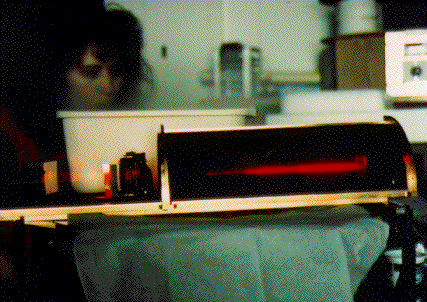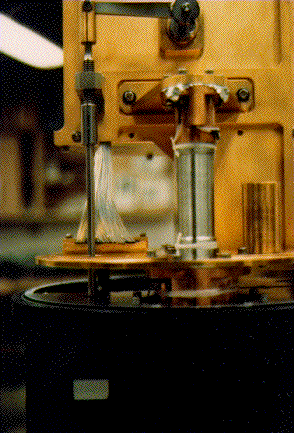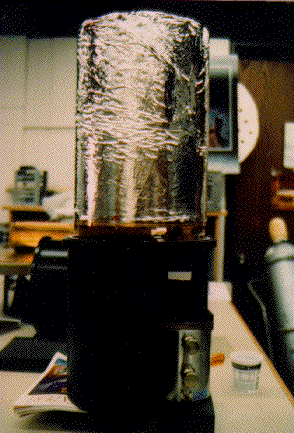Denver University's
TWO GRATING MID-IR SPECTROMETER
(TGIRS)
Denver University
Department of Physics and Astronomy
Denver, Colorado 80208 USA
Update May 2001: TGIRS rehab'd and testing underway... see www.du.edu/~cjurgens



1/97 Info pertinent to TGIRS data
---AAS/Toronto---------Instrumentation-------------------
-----1997 BAAS...28,1370----------
Title: FIRST LIGHT REPORT ON TGIRS - DU's NEW MID IR SPECTROMETER
Authors: R. E. Stencel, M. J. Creech-Eakman, D. Klebe, W. J. Williams
We present a first-light report on TGIRS, Denver University Astronomy Program's
new Two Grating mid-InfraRed Spectrometer. The instrument was designed and
assembled in a little over a year, has been tested in the lab and will be
acquiring data at a telescope. The TGIRS spectrometer was built
specifically to study the variability of mid-IR silicate features in the
spectra of Long Period Variable stars. We plan to present alignment and
throughput test results, along with sample spectra over its bandpass of 7 to
14 microns, at resolutions of about 500.
A novel feature of TGIRS is its use of a the mechanical cryocooling system
that utilizes a Gifford-McMahon cryocooler. We will report on the success of
vibrational isolation of the detector and optics from the piston action.
The design and construction of this instrument forms the basis for a PhD by
graduate student MJCE. We plan for TGIRS to become a facility instrument
at our newly built Meyer-Womble Observatory, one of the highest observatories
in the world, at an elevation of 14,148 feet, atop Mt. Evans near Denver.
From this vantage, above 90 percent of the telluric water vapor, we anticipate
that substantial quantities of spectra can be obtained for monitoring studies.
6/96
TGIRS: A New Twin Grating Mid-Infrared Spectrometer --
Additional references:
Creech-Eakman, M., Klebe, D., Stencel, R. and Williams, W.J.
1996 Bulletin Amer. Astron. Soc. Vol. 28, p.962; SPIE 8/96 Denver meeting.
The Two Grating Infrared Spectrometer (TGIRS), a new mid-IR array, dual
grating spectrometer for the 7.0-13.8 $\mu$m region built at the
University of Denver (DU). This instrument has been designed to monitor
silicate features in evolved stars, but is flexible enough to accomodate a
variety of astrophysical investigations. The instrument uses
diamond-turned aluminum optics to allow warm optical alignment and
eliminate differential contraction of the optics while operating at 6.5~K.
Two gratings are used in the optical design to provide a resolution of
about 800. The first grating cross disperses the flux into several orders,
8-14. The second grating is the high resolution grating which disperses
the flux into each of the above orders over the wavelength range of the
instrument. This second grating has two position settings controlled by a
swing arm device to allow for both maximum spectral coverage and
efficient use of the array detector with the least amount of moving
hardware. The entire assembly is cooled with a Gifford-McMahon
refrigerator so that it may later be adapted for use during remote
observing. The array is a Rockwell 128X128 Si:As BIB Hybrid Focal Plane
Array, with 75$\mu$ pixels, sensitive to 26 $\mu$m. The dewar is being
custom built by J. K. Henricksen and Assoc. in Vista, CA. Short wavelength
IR and optical radiation is blocked with a long pass filter. The slit of the
instrument is 1"X 4" allowing for both spectral and spatial coverage of the
objects being studied. The electronics package and software for readout
were developed by Wallace Instruments and are already in use on our
TNTCAM at DU. TGIRS "first light" scheduled for winter '97.
Return to Mt.Evans Observatory homepage.
(www.du.edu/~rstencel/MtEvans/)